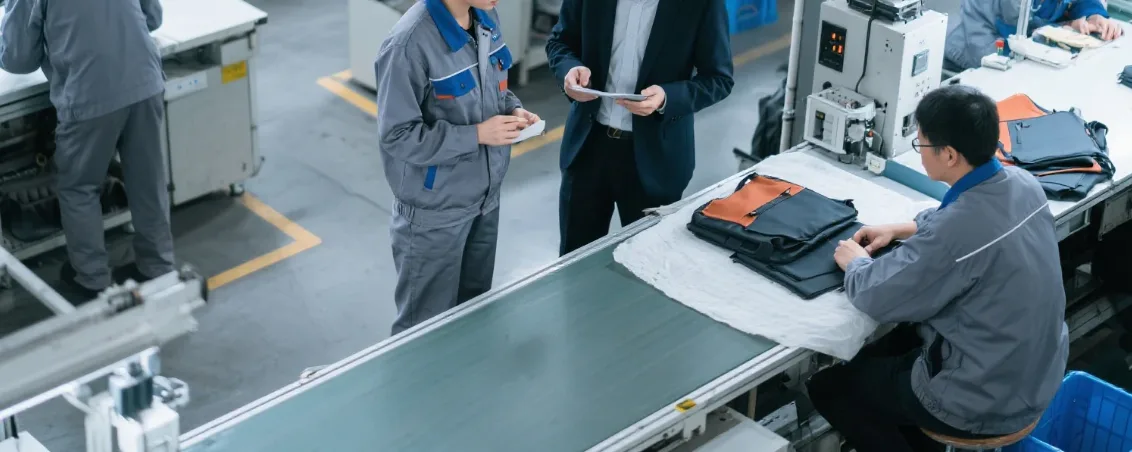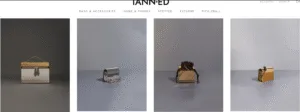In the highly competitive luggage and bag market, product quality directly influences brand reputation and customer loyalty. For bulk orders of custom briefcases, a scientific and rigorous quality control system is not only essential to prevent defects but also the core guarantee for enhancing product consistency and durability. Whether it’s high-end business briefcases or multifunctional travel models, even minor oversights at any stage—from material selection to production and delivery—can escalate into widespread risks in large-scale manufacturing.
This guide, grounded in industry standards and practical experience, systematically outlines key quality control points for bulk briefcase production, covering:
Full-process quality inspection stages (materials, design, production, final inspection)
Efficient sampling methods (AQL, double sampling, etc.)
Common defect analysis and countermeasures (sewing, hardware, structural issues)
Quality control strategies for different production scales (bulk vs. small batch)
Application of international certification systems (ISO, BSCI, etc.)
Through standardized procedures and proactive management, both brands and manufacturers can significantly reduce rework costs and ensure every briefcase accurately reflects the brand’s value.
Contents
1. Full-process quality inspection stages (materials, design, production, final inspection)

Handling the task of mass production of briefcases, quality control is absolutely crucial. For any brand, the sustainable success of custom products largely depends on whether each item is consistent, durable, and aligned with the brand’s image. Throughout my experience with numerous custom briefcase projects, we always adhere to the principle of “solving problems at the source,” ensuring effective quality control at every stage.
A high-quality briefcase starts with strict material selection. We carefully inspect every component, including leather, fabrics, zippers, hardware, and lining, making sure they meet production standards. Consistency in color, texture uniformity, and material durability are all key points in our inspections. Some orders require advanced testing such as abrasion resistance, moisture resistance, and tensile strength tests, to ensure the final product not only looks great but can also stand the test of time.
In custom briefcase projects, clients often have very specific requirements for details. Therefore, we thoroughly review all design drawings and produce samples for comparison against specifications in size, structure, and functionality to avoid costly rework later on. Special attention is given to brand markings such as embossed logos, metal badges, or embroidered patterns, focusing on their placement, craftsmanship, and visual consistency to faithfully represent the brand identity.
Production Preparation Stages: Ensuring Stability in Bulk Briefcase Manufacturing

Before production begins, we assess the factory’s capabilities, including equipment condition, workforce skill levels, and quality management systems. An experienced production facility is essential to handle potential process variations that can arise during the mass production of briefcases. We pay close attention to the factory’s ability to deliver on time and respond to unexpected quality issues, reducing supply chain risks.
Once production starts, we establish multiple inspection checkpoints. The first is the initial sample inspection, confirming that the first batch meets standards in dimensions, color, zipper smoothness, and more. During production, we perform periodic spot checks to verify uniform stitching, secure hardware attachment, and adherence to craftsmanship details.
If any nonconformities are found, corrective actions are implemented immediately, and production may be paused to prevent defect spread. Finally, every finished briefcase undergoes a comprehensive final inspection, including appearance, structure, function, and packaging. Random sampling tests ensure consistent quality across the entire batch.
Quality Is the First Impression of Your Brand
For any brand aiming to expand market share, choosing a manufacturer with a mature quality control system is the first step to success in custom briefcase projects. By maintaining full-process quality control—from raw materials and design review to production management and final inspection—we don’t just deliver products, but a reliable promise to our clients.
2. Sampling Methods for Bulk Briefcase Orders(AQL, double sampling, etc.)

To ensure the exceptional quality of your bulk custom briefcases, we focus on key aspects such as precise dimensions, weight consistency, color uniformity, and material quality. Each briefcase is strictly controlled within a ±3% weight tolerance to guarantee customer satisfaction. Hardware components like zippers and buckles undergo repeated testing to ensure smooth operation and durability, while adjustable straps and handles are checked for flexibility and reliability. We also perform metal detection to ensure safety and product integrity. Additional tests include drop tests and coating adhesion tests to confirm durability and long-lasting appearance. Our comprehensive quality control process covers Incoming Quality Control (IQC), Process Quality Control (PQC), Final Quality Control (FQC), and Outgoing Quality Control (OQC), ensuring strict checks at every stage. To provide objective and authoritative quality assurance, we collaborate with reputable third-party testing agencies such as SGS and BV, offering independent professional evaluations to help you fully understand and trust the product quality, ensuring your briefcases meet the highest standards upon delivery.
Building on this rigorous quality inspection, adopting an effective sampling method is crucial to efficiently verify the overall quality of your bulk order without inspecting every single item. Next, we will introduce several commonly used sampling methods.
Method A. Classical 4-Step Sampling Technique

I often recommend this 4-step technique for large briefcase orders:
1. Develop a Sampling Plan: You’ll need to decide on your sample size and how you’ll select them. I suggest making sure the plan fits your order size and what you expect in terms of quality.
2. Collect Samples: You should take sample briefcases from different parts of the whole batch. It’s important to pick items without any bias, in my opinion.
3. Prepare Samples: Get each sampled briefcase ready for checking. This helps show their true quality.
Just picking samples randomly, like taking 10% of the goods, is not good enough. This approach doesn’t really safeguard the buyer against patchy quality. It also doesn’t give clear rules for rejecting a batch if you find problems.
Method B. Statistical Sampling Plans
Statistical sampling plans offer a solid, scientific way to inspect bulk briefcase orders. With these plans, inspectors check a pre-set number of samples instead of every single item. This saves a good deal of time and money, from what I’ve seen.
Method B1. AQL Inspection (Acceptable Quality Level)
Method B2. Double Sampling Plans
With double sampling, I explain it as taking two different samples before you decide to accept the whole lot of briefcases.
Parameters:
n1: This is the number of briefcases in your first sample.
c1: This represents the most defects you’ll allow in that first sample.
n2: This is how many briefcases are in the second sample, but only if you need one.
c2: This is the maximum defects allowed in the second sample.
In conclusion, selecting the right sampling method is essential for ensuring the overall quality of bulk briefcase orders. Compared to random checks, scientific approaches such as AQL and double sampling significantly enhance inspection efficiency and provide a clearer basis for determining whether a batch meets quality standards—ultimately reducing risk and increasing customer satisfaction.
3. Common Defects and Production Scale Analysis

While effective sampling methods help identify quality issues early, understanding the most common defects and how they differ between small and large-scale production is equally important for long-term quality control.
Common Defects in Briefcase Products
| Defect Category | Specific Defects |
|---|---|
| Color / Dyeing Issues | Uneven dyeing |
| Discoloration / Color fading | |
| Fabric Defects | Pilling |
| Fabric tears | |
| Holes | |
| Stain / Appearance | Dirty stains |
| Wrinkles | |
| Stitching Defects | Poor stitching |
| Untrimmed threads | |
| Broken seams | |
| Needle / Yarn Issues | Needle holes |
| Yarn draw out | |
| Hardware Defects | Defective buckles, locks, or zippers |
| Handle / Strap Issues | Weak handle or strap |
| Lining / Compartment | Lining or compartment defects |
| Size / Design Errors | Incorrect dimensions or design mistakes |
| Labeling Issues | Poorly sewn care labels |
Material Issues

Defects such as uneven dyeing and fabric fading can significantly compromise a briefcase’s overall aesthetic. Pilling and tearing often indicate poor fabric quality or improper handling. Wrinkles and stains may result from substandard storage conditions, while yarn pulls and loose threads typically point to inadequate process control—issues that ultimately affect both appearance and durability.
Assembly and Workmanship Defects

Poor stitching—such as uneven seams, loose threads, or skipped stitches—is one of the most critical concerns, as it can cause seams to split under stress. Untrimmed threads and broken seams weaken structural integrity and degrade the product’s look. Needle holes, especially in waterproof models, can lead to leakage. Other frequent problems include zippers sewn into seams and misaligned reinforcements, which hinder functionality and user satisfaction.
Hardware and Component Failures

Handles and straps that aren’t properly reinforced often detach or break, diminishing usability and customer trust. Malfunctioning metal components—buckles, locks, or zippers—frequently fail under pressure if not manufactured or assembled to standard. For wheeled models, defective wheels or jammed trolleys are serious issues that compromise product function.
Interior Construction Problems
Loose linings, poor stitching, or torn interiors reduce a bag’s practical use. Inaccurate placement of pockets or misaligned patterns can severely affect usability and even render an entire batch unsellable. Interior design flaws can also damage a brand’s image when consumers expect both form and function.
Other Frequent Issues and Observations
Reviewing inspection data, over 40% of cosmetic defects during bulk checks stem from untrimmed threads and stitching problems. Stains and creases are common in 15% to 20% of rejected batches, often caused by poor handling during transit. Poorly sewn care labels or punch holes may seem minor, but they influence both regulatory compliance and customer perception.
Conclusion
Recognizing these typical defects—and their causes—is essential for maintaining high-quality standards, especially for custom bulk orders. Establishing a detailed production sample and clear inspection checklist, including tests like drop tests, color fastness, and coating adhesion, ensures you detect inconsistencies early. Ultimately, thorough quality control safeguards your brand reputation and minimizes costly rework.
Recognizing these defects is critical—especially in large-scale production, where even small issues can escalate and affect thousands of units. This leads us to an important consideration: the quality control challenges differ significantly between high-volume and low-volume orders.
| Aspect | Bulk Production | Small Batch Production |
|---|---|---|
| Defect Rate | 1–3% (per 1,000 units) | <0.5% |
| Correction Speed | Slower | Immediate |
| Customization | Limited | Very flexible |
| Price per Unit | Lower | 15–30% higher |
Large-Scale Production: Efficiency with Greater Risk Exposure
In large-scale production, the primary focus is on speed and cost-efficiency. Automated processes and assembly-line setups are highly effective for meeting tight deadlines and producing thousands of identical briefcases. However, these benefits come with risks. I’ve found that even minor issues—such as misaligned seams or inconsistent stitching—can multiply quickly if not caught early. Defects often go unnoticed until hundreds of units have been completed. This means rework is costly and time-consuming. Although quality control systems like in-process sampling and final inspections are essential, there is still a higher likelihood of discovering defects post-production, which can compromise customer satisfaction and brand reputation.
Small-Scale Production: Precision and Flexibility at a Higher Cost
In contrast, small-batch manufacturing allows for more attention to detail. Each briefcase receives closer inspection, and adjustments can be made quickly. From my observation, small-volume runs are ideal for custom features—such as unique linings or hardware variations—and allow for higher flexibility in design. Errors are often identified and fixed in real time, resulting in lower defect rates and fewer customer complaints. However, this level of craftsmanship comes at a premium: the unit cost is typically 15% to 30% higher, as overheads can’t be spread across thousands of pieces. Still, for brands that prioritize quality and uniqueness, this tradeoff is often worth it.
4. Quality Assurance Systems and Practical Implementation

In the production of customized briefcases, establishing a robust quality assurance system plays a crucial role in controlling defect rates and improving product consistency. Most briefcase manufacturing factories implement general quality management systems such as ISO 9001 to standardize material inspection, process monitoring, and final product testing, ensuring orderly and traceable production processes.
For specialized applications, some factories adopt more specific standards—for example, ISO 13485:2016 for medical-related orders, and FSSC 22000 for products intended for food contact. These certifications help enhance product safety and compliance, especially in markets with higher demands for traceability and risk management.

Meanwhile, environmental and social responsibility are becoming integral to quality systems, with certifications such as BSCI (labor standards) and GRS (use of recycled materials) gaining prominence.
Overall, factories that hold these certifications generally demonstrate more comprehensive quality management capabilities, are better positioned to enter high-threshold markets, and effectively reduce rework and customer complaints.
Building on these quality assurance frameworks, the following section introduces how Sunteam implements high-standard quality management in customized briefcase orders.
Sunteam strictly follows the ISO 9001 quality management system throughout its mass briefcase production, ensuring every production stage is standardized and traceable. The company has multiple quality checkpoints, including incoming material inspections, in-process sampling, and final product functional testing, ensuring that each briefcase meets client expectations in both appearance and durability. For special orders, Sunteam applies stricter custom standards tailored to client requirements and integrates BSCI social responsibility certification to ensure compliance with environmental and labor regulations. These measures effectively control defect rates, improve customer satisfaction, and guarantee high-quality delivery of every batch of briefcases.
Conclusion
Quality control is a systematic process that spans the entire product lifecycle, requiring comprehensive oversight from source to endpoint. For customized briefcase orders, establishing a robust quality control system involves several key steps: first, front-end risk management through material testing, sample validation, and pre-production evaluation to eliminate potential issues early; second, dynamic monitoring during production using statistical sampling and critical inspection points to detect and intercept defects in real time; and finally, terminal verification by authoritative third-party agencies such as SGS to provide objective quality assurance. Whether for large-scale batch production or small custom orders, embedding a strong quality mindset throughout every link of the supply chain is essential to consistently deliver products that satisfy clients.
Leading briefcase manufacturers like Sunteam achieve this by implementing ISO certification, multi-stage quality inspections, and closed-loop defect management, continuously elevating product quality from “acceptable” to “exceptional” and ensuring every briefcase becomes a silent ambassador for the brand.






